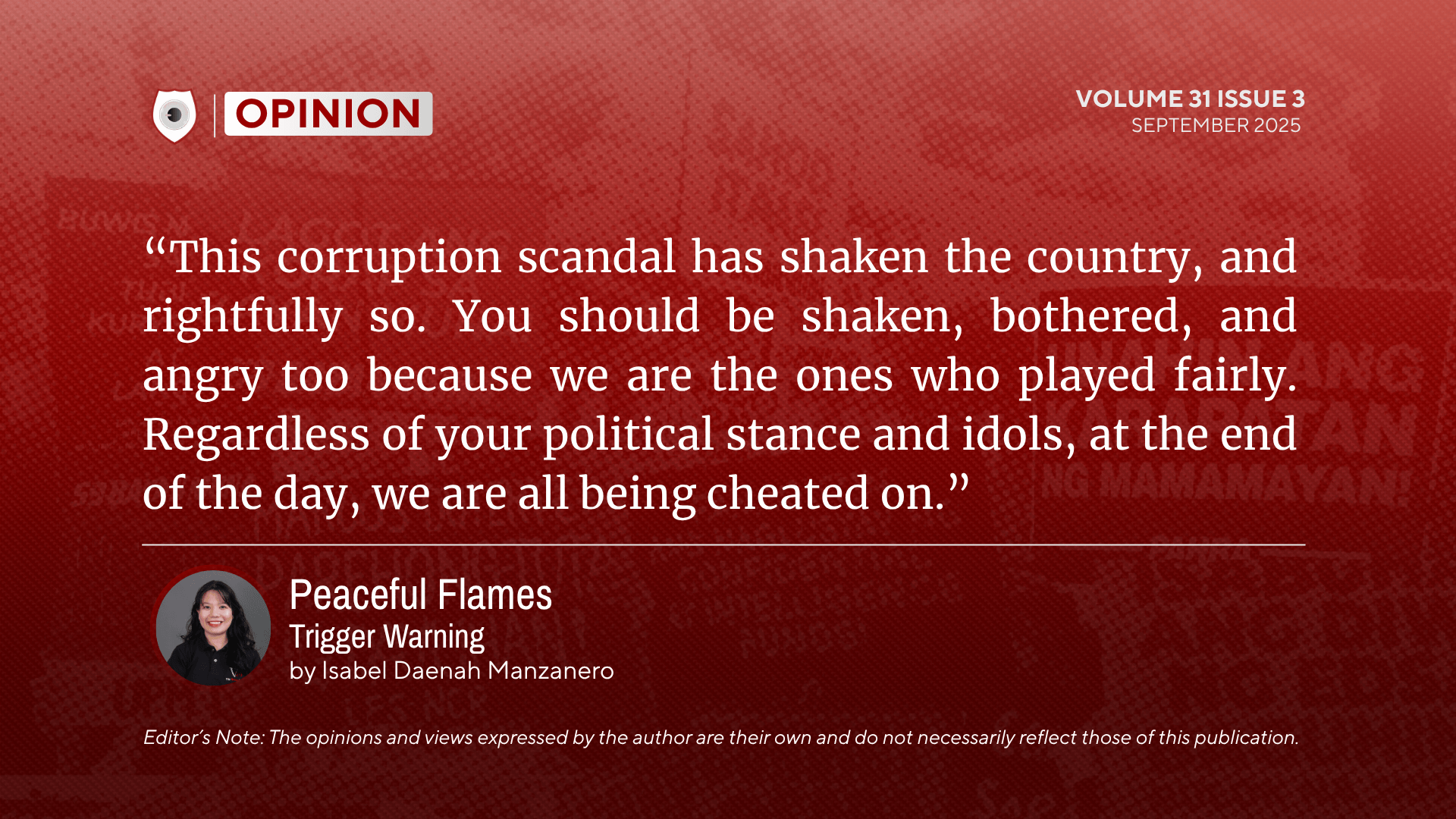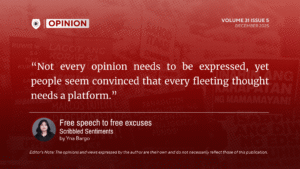Written By Isabel Daenah Y. Manzanero | October 01, 2025
Peaceful Flames
"’DI mo ba naririnig? Tinig ng bayan na galit?” is how the Filipino version of the popular song “Do you hear the people sing?” from Les Misérables goes as the play recounts the French Revolution. The Filipino version of the song was produced in 2017, not only translating the message of strengthened democracy in the country’s political landscape. To this day, the song remains relevant, especially at times where the government is abusing their power and committing atrocities that leave the citizens bare to face the consequences.
With how the government continues to treat its people, many would think that an aggressive fight against these abusers would be the answer. Would that have been easier? Setting their homes, offices, and all their wealth taken from the pocket of the people on fire? But with the recent protests last Sept. 21, most Filipinos appear to still opt for a peaceful fight.
Our country has its fair share of revolutionary movements, but we are mostly known for our peace rallies. Even after years of witnessing blatant corruption, aggressive mistreatment of democracy, and the lack of public service from the nation’s leaders, Filipinos still choose to fight for their rights peacefully. One of which happened recently, last Sept. 21, to demand accountability for what is deemed the biggest corruption scandal in Filipino history.
Around the world, while the details on the corruption scandal slowly unravel, Indonesians and Nepali took matters into their own hands and went to the streets, no longer letting their government trample all over their rights. Some would even compare these demonstrations to the French Revolution; videos on social media overlapped with the famous song from Les Misérables.
In Indonesia, legislative buildings and parliamentarians’ homes were set ablaze and plundered, heightened from political and economic frustrations. The thousand housing allowances of lawmakers were compared to the low minimum wages of their workers.
Triggered by blocking social media platforms, decades of corruption, and restricted economic opportunities, the Nepali protesters set their Supreme Court and other government buildings on fire. At least 22 individuals died, leaving hundreds of people injured. Ironically, one of the issues that fueled their anger was the “Nepo Kids,” children of the politicians, flaunting their lavish lifestyles that further showed the stark contrast of the lives of Nepalis.
Doesn’t everything sound familiar? Children of famous contractors shamelessly post about their lifestyle on social media for everyone to see, showing where the people’s taxes truly go. Even the contractors themselves, specifically Cezarah Rowena “Sarah” Discaya and her husband, Pacifico “Curlee” Discaya II, go as far as agreeing to an interview to blatantly go through every area of wealth they have. This being the match that ignited the flame to call out those in power.
But even with the troubling similarities with how the government treats its people, why do Filipinos continue to choose peace? Why has it not marched to Malacañang with torches on fire and itaks at hand?
This could be attributed to the success of people power revolts before, such as EDSA 1 and 2. One of the sectors calling out these injustices are religious organizations that advocate for peaceful assemblies. The most “violent” rally the Philippines has taken part in was in 1986 which was an extension of what happened in EDSA, when the people forced the Marcos family to leave Malacañang, but even that demonstration is a big difference from what happened in Nepal and Indonesia.
Interior and Local Government Secretary Jonvic Remulla said in a Philippine News Agency report that a protest like Nepal’s was unlikely to happen. Even Pasig City Mayor Vico Sotto calls on the people to not resort to violence because not only will corrupt officials get injured, but also workers and protestors.
Regardless, the Philippine National Police said in a GMA article that it has a security plan to avoid an aggressive protest from happening. They are so fixated on creating a solution to a hypothetical scenario when the root cause of why it is about to happen remains unaddressed? Yes, it is the police power of the state, but when it is used against the people it aims to protect, where does duty stand? During the Trillion Peso March after the protesters mobilized to Mendiola, there have been reports and video evidence of gunshots and tear gas fired. The Department of Health released a report of 48 injured individuals and one dead on arrival from a stab wound.
What does this tell us? That even if the people protested peacefully, there would still be violent acts originating from different sides. There are protests because people want to be heard; they demand to be heard. Tax is the lifeblood of the government, but it's slowly draining the blood of the people after hours of working, only for it to go directly to the pockets of these corrupt officials, their cronies, and their families.
This corruption scandal has shaken the country, and rightfully so. You should be shaken, bothered, and angry too because we are the ones who played fairly. Regardless of your political stance and idols, at the end of the day, we are all being cheated on.
So, what do we do? We continue the fight; these demonstrations will not end with one collective rally. We continue to demand what the Filipino people rightfully deserve, and we continue to educate one another. We continue to question and bring up issues regardless of how long it has been, as long as it remains unsolved, as long as it's for the people. We cannot let anyone silence us.
Now, do you hear the people sing? Are their voices clearer? Their cries of transparency and accountability louder? When the people sing together even without wanting to listen, their chorus echoes and like fire it becomes harder to contain the longer you ignore.
Volume 31 | Issue 3




